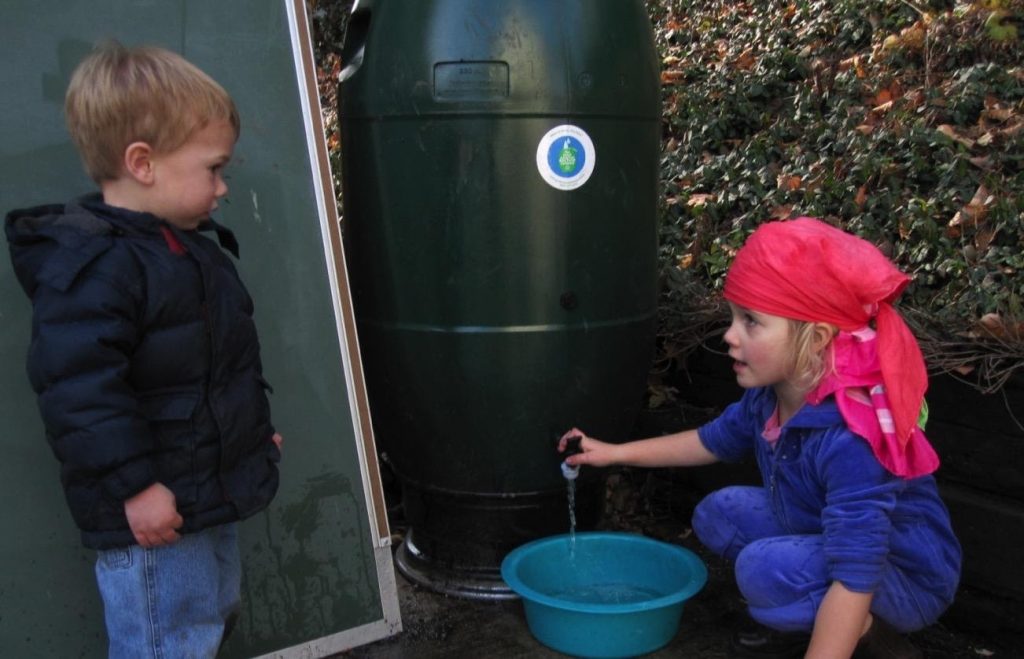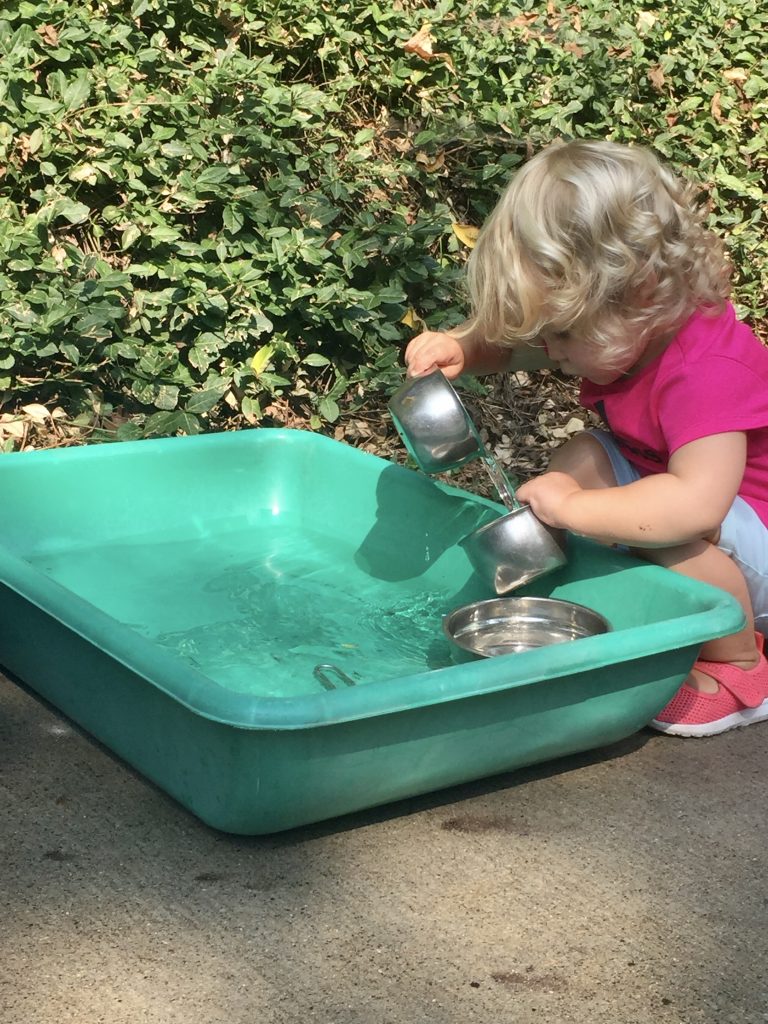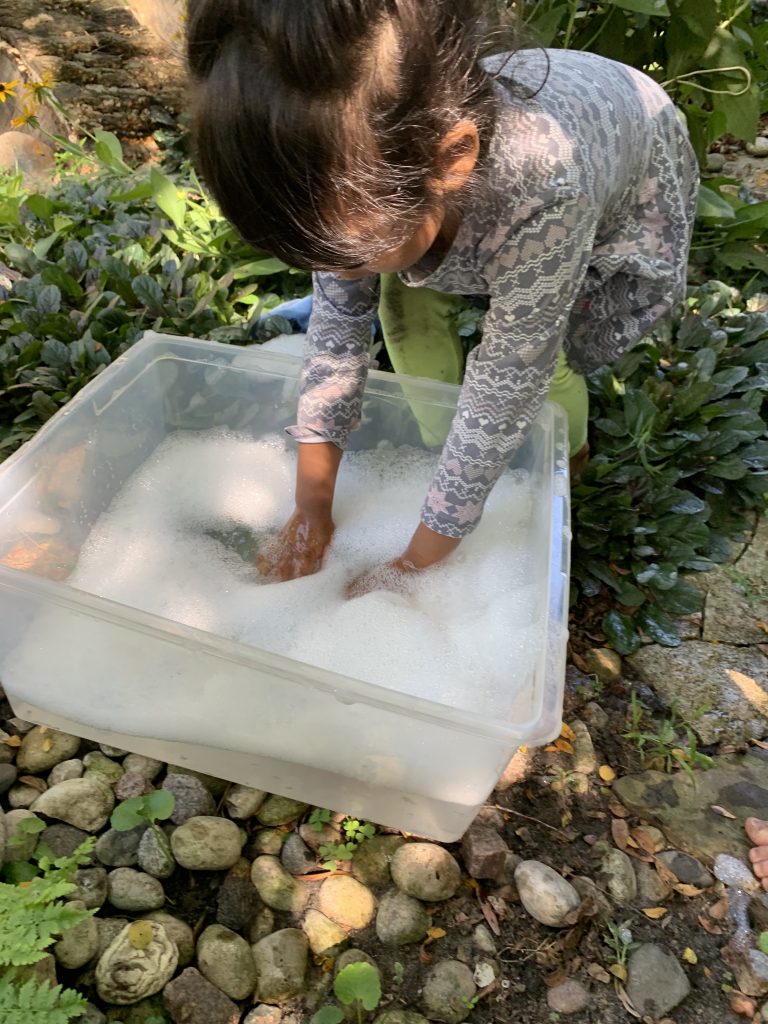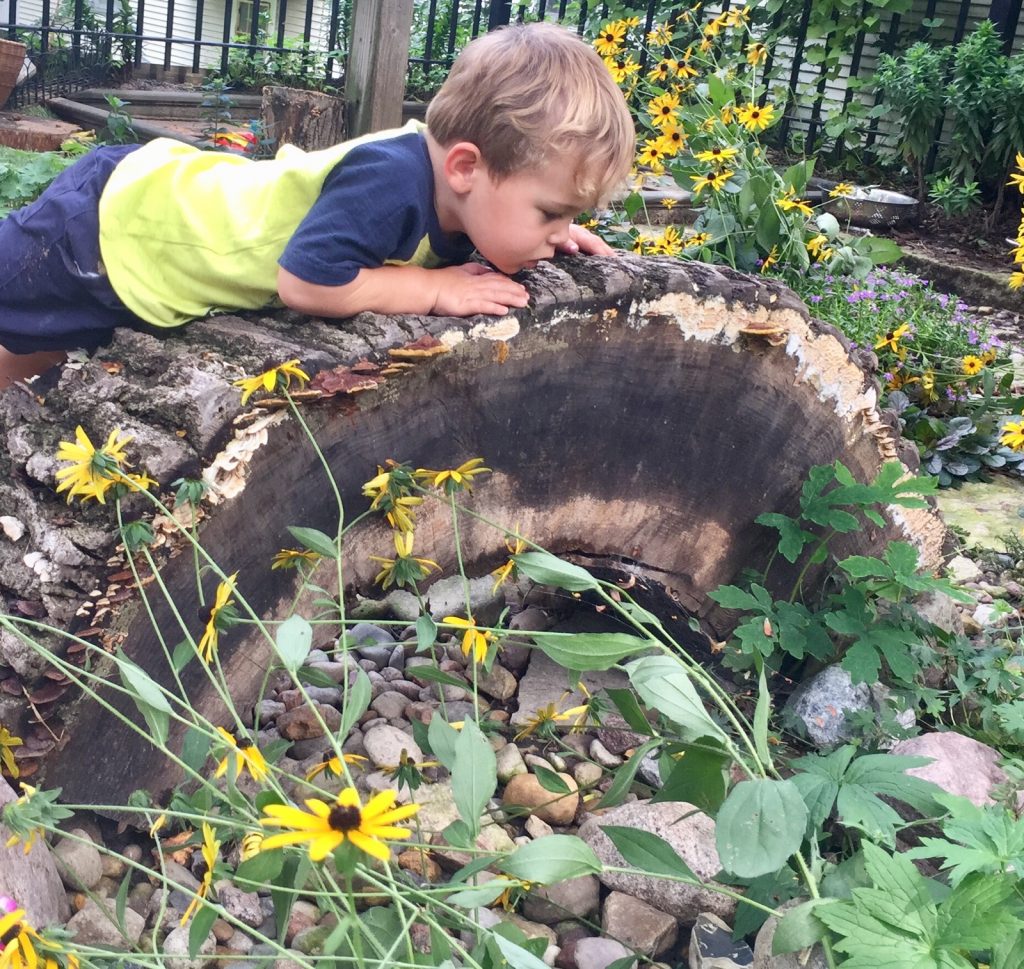Water Play!

“It works! The water is coming out!” Rokia cannot contain her excitement as the discovery of a full rain barrel adds a new avenue of discovery and learning for our week.
“How did you do that? Can I have a turn? Get a bucket!” The excitement builds as so many little brains begin to figure out what is happening here. We have hypotheses, theories and observation humming away. There is nothing like water to bring a group of children together for a day of play and learning that can help you meet your curriculum goals.
As the United States begins to open up with precautions in place to prevent the spread of COVID-19, there are opportunities to literally change the landscape of early childhood education by spending more time in outdoor spaces.
The best place for our children as we navigate this “new normal” is in nature. Studies show that sunlight, higher temperatures and humidity are detrimental to the survival of the coronavirus.
We also know that exposure to dirt helps young children develop healthy microbiomes and strong immune systems. Outdoor activities make social distancing easier—and research suggests that outdoor learning can deliver many other benefits, from boosting mood and increasing concentration to reducing stress.
You can meet many important early learning standards easily with outdoor play. And once you take your curriculum outdoors, you may never want to head back inside!
It’s important for anyone working with young children to understand the enormous potential for learning and brain development that exists when children are connected to nature. As children actively use their senses to explore the natural world, they are forging new neural connections and strengthening neural pathways through sensory play.
In short, outdoors is where our children need to be—and setting up an outdoor classroom is easier than you think. You don’ t even need to have a natural setting.
Water is a great place to start because we want the children in our care to wash their hands A LOT during the pandemic—and we can set up water play just about anywhere.

Incorporating water into our daily play with a rain barrel was one of the smartest things I ever did. We love using rain barrels for scientific exploration and discovery, as well as teaching children how to be good stewards of the earth’s limited resources. Many cities give away rain barrels for free to promote water conservation. If your city doesn’t have a rain barrel program, you can purchase a rain barrel for $50-$150 or make your own from a plastic trash can with a lid.
The children love to use the spigot on our rain barrel to explore the concept of flowing water and control the water’s flow. Let me tell you, being in control of something so powerful is a pretty powerful experience in its own right!
The communication and social-emotional skills that develop during this outdoor activity are worth their weight in gold. If your building has a downspout or an outdoor water source, that may be where you place your rain barrel. During very hot, dry summers, we sometimes have to resort to filling the rain barrel with our garden hose. By taking the time to think about these issues, you will help ensure the success of your own rain-barrel adventures.

We are also big proponents of tubs for water play. We use everything from big plastic tubs to utility tubs from auto stores to bus pans from restaurant supply stores to commercial school-supply tubs. This summer, we are adding soap bubbles to the buckets to encourage play and kill germs in a calm, not-in-your-face-scary-virus way. Doing this in front of the students will be a whole science and math lab in itself as they discuss the addition of ingredients, the change in matter, the chemical reaction that takes place and the change in physical properties. So, yes, grab those standards! This is the hands-on learning that we love—all while keeping our children safe from germs!

We were fortunate to have a handyman in our lives with the vision and skill to create a working pump. We buried a short, wide rain barrel and connected it to the farmhand pump. If you’d like to give this a try, you can get the step-by-step directions here. This pump has added hours and hours to our investigations and play. We absolutely LOVE our pump, and it is one of the most popular additions to our outdoor classroom. Many an hour has been spent here learning about cause and effect as the children see “what happens if….” Trust me, they have investigated the craziest ideas that adults just wouldn’t conceive of!

“Eve, come see! Look what’s crawling under the bridge!” Jamison has discovered a daddy longlegs out for a morning stroll in our rain garden. Many cities and towns across the U.S. are beginning to award grants for rain gardens. We took advantage of our local grant program and created a rain garden filled with native pollinating plants and a dry creek that gifts us with insects, an occasional toad or two, and plenty of opportunities for exploration, observation and investigation.

Last summer, we added a mister connected to a simple garden hose to our tree. With pools closed during the pandemic, this mister (which we ordered from Amazon) is a great alternative that you can take advantage of without great expense or worries about water safety. We supplement the mister with big tubs of water and plenty of buckets and spray bottles. Heavy buckets of water and spray bottles are great resources for building strong arms, wrists and fingers for future pencil gripping. Bring in measuring cups, measuring spoons, tall containers and short wide containers and you have set your students up for outdoor learning activities that will foster the development of predicting, data analysis, probability and geometry skills.

It won’t take the children long to figure out that the mister will afford them many opportunities for water collection. This, in turn, will encourage pouring and measuring and experimenting with volume. Nearby plants, flowers, rocks, shells and other loose parts will add to the value of the play. When children make dandelion soup or rock salad, they are combining, collaborating, creating and imagining. It’s all there for us to document. They don’t need worksheets, they need play!
As we navigate our way around the pandemic, maybe we need to return to the roots of early childhood education by taking a page from the playbook of the German educator and nature lover Friedrich Froebel, who founded the first kindergarten (which translates literally to “children’s garden”). Froebel’s original kindergarten model in 1837 emphasized time and opportunities for children to connect with natural materials in a garden for play. Maybe this is what kindergarten could and should emulate as we reimagine early childhood education this year.
All of the activities that you need to meet your math and science standards are awaiting you in the garden. Head outside and lay the foundation for math and science success with a developmentally appropriate day of nature play.
Let’s take back what early education could look like in America. Join me!
Thank you for the wonderful ideas I love activists outside and I encourage our children to explore when out door with nature and I know it working . I will try the water ideas more the children will love it and so will I thanks again
Thank you. I have observed that children love to paint with soapy water outdoors also.
LaTonya Gordon
Water play can be a great idea to encourage children to start washing hands in a fun way.
The new norm has taught us various ideas that children love to do with outdoor play with water and soap, its bubbly and a exciting to children
Outside water play is a great idea especially with everyone home all the time.
I agree that it would be beneficial to encompass as much outdoor activity as possible during this time and that children can learn just as much about geometry.
It would be as beneficial for teachers as for children!
Water play is fun for everyone! Children of all ages enjoy splashing, pouring, measuring, experimenting, etc. Potential for such a wide variety of activities with water play.
I have also found that children love playing in water whether it is a car wash for their bikes or toys. I loved all of the activities that you set-up for the kids because we all know how much kids love exploring and the water is just a bonus.
Great way to get the kids moving, exploring and having fun with water!
The “Water Play!” adventure is educational and offers all the benefits of outdoor play during historic 2020: heat & Vitamin D from the sun, work in the soil to help develop immunities, exploration from the variety afforded by outdoor play and the cooperativeness of interacting with peers on a beautiful day. I’ve decided to replicate some of this adventure with my preschool daycare kids — affording them the opportunity to use measuring cups and bowls to learn what works as we exchange the utensils, ideas, and new vocabulary we’ve learned.
Water play is great fun for all ages and it is something that can be done inside and outside. There is so many things that can be done and the children do not realize that they are learning.
Great way for kids to not only have fun but also learn at the same time.
I’m glad to have come across this blog. I really liked all the potential activities for children to take part in while outside in nature. I too am a believer of children learning outdoors and it boosting their moods. They can collect so much different data outside such as rocks, flowers, shells, and leaves for investigating. I also liked that misting idea for hot days at home as well as the idea of using soap with water play to promote hand washing in a fun way.
some great and interesting ideas
All kids love playing in water all sizes small children and large children adults as well. kids love doing water with with colors and bubbles in water tables cups in there and filling jars and water balloon filling and pouring water in bowels and threw water turnail. water time is a good time for having play time and math time with learning measurement.
water play offers many great ideas for collecting data
The children I really enjoy washing baby dolls in the water table.
The water play activity using the rain barrel will have my three years old very excited I will use this idea. I have 55gal barrel the children has been curious about, and now I can incorporate into my program. Now we can get water to water the garden as well as introduce math.
Water play is the best !